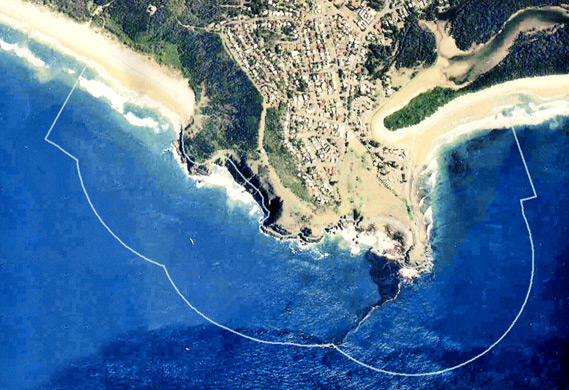Crescent Head National Surfing Reserve stretches along 3.5 km of spectacular coastline either side of the Head. Crescent Head became a well worn trail for surfers following World War II and became widely recognised as a breeding ground for long board surfing in Australia. One of the longest and most classic right hand point breaks in Australia.

A Place for all Creatures
The marine and local habitats, enjoyed by all those who visit Crescent Head, include the rocky pools of the shore, which are tiny microcosms teaming with starfish, sea urchins, sea snails, crustaceans and tiny fish.
Crescent Head has the best surf
Midget Farrelly: World Surfing Champion (1964)
The sand dunes are host to ghost crabs and are stabilised by the native grasses. Higher up the shores are dotted with ruggedly beautiful pandanus palms. Off the shoreline the area enjoys casuarinas, banksia, tuckeroo and paperbark varieties. The Sea is abundant with black fish, bream, and drummer feeding off the Black Boulder. Pelagic species including taylor, mackeral and salmon move through and jewfish provide a thrill for recreational fisherman.
Surfers are often joined on the waves by dolphins and Crescent Head is visited by migrating whales as they cruise north and south annually. Stingrays are often seen basking on the sand and loggerhead turtles are a special treat when surfing the point. The sky an surrounds are home to the osprey, brahminy kites and seagulls. Pelicans also visit the creek dwellers and fishermen.
The Dunghutti People
Crescent Head lies in the middle of the eastern border of the lands of the Dunghutti people. Dunghutti people lived in harmony with the land and their pattern of life was governed by codes of conduct regarded as sacred, having been handed down through countless generations.
The Dunghutti people crafted canoes from the bark of the canoe tree and used them whilst hunting and fishing in Killick Creek. There was a track on the Maria River Road through to Crescent Head, which was created by Dunghutti people and also used by early settlers.
The First Surfers
The first person to surf the Crescent Head point break, using a surfboard as we know it today, as John Westaway in the 1950s. John had to obtain permission from the Kempsey – Crescent Head SLSC to use the board.
In 1958 John Westaway, Bob Marvin and David Cheers purchased solid balsa boards in Newcastle and took to the waves. Other surfers soon followed.
Surfers who discovered the swell and magnificent sets of Crescent Head would camp over weekends, often leaving their boards at the beach until their return the following weekend.
Bob Evans started Surfing World Magazine in 1962, and arrived in Crescent Head in 1963 with a team of 25 experienced surfers including Midget Farrelly and Alby Falzon. A good three to five foot wave with perfect conditions meant the word spread fast about Crescent Head.
Midget Farrelly once commented that Crescent Head had the best surf in the area, and by the early 1960s approximately 20 surfers were regularly surfing the point. Soon after in 1964 Midget won the first World Surfing Championship, and this opinion attracted many more surfers to explore the location.
Midget Farrelly and Bob Evans would have the reputation forever for establishing Crescent Head “the first stop on the surfers NSW North Coast journey in pursuit of the perfect wave”.
Crescent Head Waves are Special
This truly unique right hand break is characterised by a 300m length of ride and the consistent wave formation means it is suitable for all levels of surfing.
Crescent Head is a sleepy township nestled in the side of its high grassy headland, protected from the southerly winds. At the base of the headland the shoreline is formed by large cobblestones that curb around to the entrance of the river mouth and continues on to form semi-circular shaped beach some 10 miles long.
The area from the point at Crescent Head to the river mouth is entirely rock bottom which forms the basis for a really consistent wave shape. The Take-off area on the point produces a fast tubing wave which drops onto the shallow reef. The wave then follows the curvature of the shore-line pealing off in walling-up hot-dog shape until you reach the final build-up into an exhilarating shore ride. Such a ride ends up in the mouth of the river, a distance of some 300 yards from the point.
It is vital to the community of Crescent Head that we preserve the area to ensure that the younger generations will enjoy the rich surfing culture of those who rode the waves before them.
The Surf Reserve
The local community has a long history of working together to protect the natural environment and to preserve their way of life. There have been many small projects, petitions and achievements dating back;
- In 1996 six melon head whales beached themselves and they were all successfully recovered and nursed back to good health by Crescent Head locals.
- In 2000 a campaign to restrict the development of a prawn farm at Racecourse Beach was also successful, and Racecourse Beach remains untouched today.
- 2002 saw Crescent Head win the regions “Keep Australia Beautiful” award.
In 2008 the Establishment of a National Surf Reserve to share, protect and preserve this special place will ensure its safe keeping forever. Crescent head stood out as boldly as its proud headland – to be finally recgonised as one of the worlds great surf environments. Few other places embody the connection of our famed Australian surf culture as classically as the love affair that surfers have enjoyed with their beloved Crescent Head, following on from the belonging of the indigenous people of the area. Its richness in so many personal connections with surfers from north to south, and world over make Crescent supremely worthy of the auspicious status of a National Surfing Reserve.
